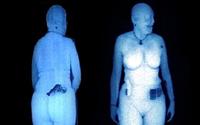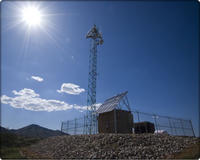-
Jails turning to full body scanners

Cook County Jail in Chicago recently installed four full-body scanners to help improve security; officials say that the body scanners have enabled officers to better detect contraband items, hidden away in body cavities, and reduced the need for strip searches; the machines are located in the jail’s two maximum security areas as well as the initial processing area; officials say they plan to begin using body scanners at the Cook County courthouse to scan detainees before they enter the courtroom
-
-
Video Surveillance Clock keeps watch
If you want to keep an eye on the goings-on in your home or office while you are away, you may want to consider the Video Surveillance Clock; the small (2 3/4″ Diam. x 3/4″ D ) analog clock has a built-in, motion-activated video surveillance camera that records both audio and video and takes photographs too
-
-
Do security cameras deter crime?
As federal agencies, cities, and local police departments spend more money on vast networks of closed circuit surveillance cameras, some critics are wondering whether these systems are an effective way to stop crime and a good use of resources; various studies on the efficacy of security cameras have been inconclusive; some studies have shown that cameras in Chicago and Baltimore have helped deter crime, while others have shown that cameras in Los Angeles and Britain have had no impact on crime; one critic points out that studies that show cameras are effective do not weigh benefits against spending more money on beat cops, probation programs, and other law enforcement options
-
-
U.S. communities support surveillance systems
Despite calls by the ACLU to halt the expansion of the use of CCTVs in public places, towns across the United States are eager to get their hands on the extra sets of eyes; midsized communities across the United States are installing more surveillance video cameras in an effort to cut down on crime, without having to spend more money on additional law enforcement officials
-
-
SkyWatch: surveillance as effective deterrence
ICx’s SkyWatch mobile surveillance tower help police and businesses keep an eye on crowded areas and public events, helping in deterring car theft and burglary, assault, disturbances, and robbery; ICx points out that the SkyWatch tower is designed with darkened windows so those below cannot tell if an officer is present — so whether or not the police have the ability to man it, the deterrence still works
-
-
Lack of oversight doomed SBInet, could hamper replacement
The poor oversight and contractor management that hampered the recently cancelled SBInet could plague its replacement; numerous GAO reports blasted DHS for failing to properly communicate and supervise its primary contractor Boeing; the program suffered major cost overruns and failed to deliver on project goals due to limited input from end users, shifting priorities, and poor communication; in response to criticism, DHS has hired more contracting officers and is reviewing acquisition procedures; critics are skeptical of DHS’ ability to deliver SBInet’s replacement which incorporates much of the same technology
-
-
DHS and CBP make a pitch to border security vendors
Boeing’s failure to provide a reliable border security solution has opened up opportunities for border protection technology vendors. These opportunities are offered by DHS’s proposed Integrated Fixed Towers (IFT) acquisition program which aims to replace SBInet
-
-
Cobham acquires Baltimore surveillance specialists
U.K.-based Cobham acquires Baltimore-based Corp Ten International; Corp Ten develops software to manage multiple tracking and surveillance devices in a single system, which allows real-time sharing of data and other communications between users through satellite, cellular, and radio frequency providers
-
-
Detecting criminals coming back to the scene of the crime
Criminals tempted to return to the scene of the crime may want to resist this impulse; Notre Dame University researchers are developing a tool which will reliably identify criminals who may be hanging out at the crime scene after the event; the Questionable Observer Detector (QuOD) can process any available video clips of groups of people present at the scene of event, spanning different times and locations to pick out any person who appears frequently in them
-
-
Dramatic expansion of DC surveillance camera network
Washington, D.C. is proposing a plan that would add thousands of surveillance camera feeds from local businesses to the city’s homeland security agency existing command center; the city already monitors more than 4,500 cameras placed in its public transportation system and schools; critics say that this is a poor use of resources and violates civil liberties; cities like New York, London, and Baltimore already employ this practice
-
-
Camera better than the human eye
Researchers developed a curvilinear camera, much like the human eye, with the significant feature of a zoom capability, unlike the human eye; the “eyeball camera” has a 3.5x optical zoom, takes sharp images, is inexpensive to make and is only the size of a nickel; the camera will not be appearing at Best Buy any time soon, but the tunable camera — once optimized — should be useful in many applications, including night-vision surveillance, robotic vision, endoscopic imaging, and consumer electronics
-
-
DHS pulls plug on virtual border fence project

DHS has cancelled the ambitious SBInet border security project; the project aimed to erect a virtual fence along the U.S.-Mexico border, consisting of a system of cameras and sensors which would allow officers to monitor crossings and dispatch Border Patrol agents to catch anyone entering the United States illegally; Boeing, the primary contractor, was hobbled by technical problems involving the effectiveness of video cameras and other elements, resulting in the project falling far off schedule; a year ago, after DHS had spent $672 million on the project and Boeing had little to show for the money, the project was put on hold; DHS will now look at an alternative system which is likely to rely more on UAVs and thermal imaging
-
-
Twelve research teams to develop persistent-stare, visual-intelligence systems
The U.S. military anticipates a significant increase in the role of unmanned systems in support of future operations, including jobs like persistent stare; by performing persistent stare, camera-equipped unmanned ground vehicles would take scouts out of harm’s way; these machines’ truly transformative feature will be visual intelligence, enabling these platforms to detect operationally significant activity and report on that activity so warfighters can focus on important events in a timely manner
-
-
NYC, Lockheed locked in bitter litigation
Lockheed Martin and New York’s Metropolitan Transportation Authority (MTA) are locked in a no-holds-barred legal battle over who is responsible for the problems in installing security CCTVs to monitor MTA’s tunnels, platforms, and stations; Lockheed stands to receive either $80 million or $138 million from the MTA should the judge rule in the company’s favor; in the event that the MTA wins the lawsuit, Lockheed would pay the city approximately $92 million
-
-
Sightlogix: ruggedized outdoor surveillance gear
The company was founded to address the need to create a rugged and automated outdoor video system which reduces the number of false alarms caused by outdoor environmental variations; the company’s cameras attain a large range of coverage area, reducing the number of necessary cameras, mounting poles, communications links, video, and storage channels
-
- All
- Regional
- Water
- Biometrics
- Borders/Immig
- Business
- Cybersecurity
- Detection
- Disasters
- Government
- Infrastructure
- International
- Public health
- Public Safety
- Communication interoperabillity
- Emergency services
- Emergency medical services
- Fire
- First response
- IEDs
- Law Enforcement
- Law Enforcement Technology
- Military technology
- Nonlethal weapons
- Nuclear weapons
- Personal protection equipment
- Police
- Notification /alert systems
- Situational awareness
- Weapons systems
- Sci-Tech
- Sector Reports
- Surveillance
- Transportation
Advertising & Marketing: advertise@newswirepubs.com
Editorial: editor@newswirepubs.com
General: info@newswirepubs.com
2010-2011 © News Wire Publications, LLC News Wire Publications, LLC
220 Old Country Road | Suite 200 | Mineola | New York | 11501
Permissions and Policies
Editorial: editor@newswirepubs.com
General: info@newswirepubs.com
2010-2011 © News Wire Publications, LLC News Wire Publications, LLC
220 Old Country Road | Suite 200 | Mineola | New York | 11501
Permissions and Policies
